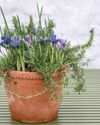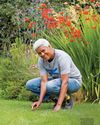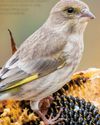
When we first came to Glebe Cottage more than 40 years ago and started to make a garden, I was advised by knowledgeable friends that the first plants I should put in were shrubs. They, it seemed, would give the garden some structure, some backbone - it seemed they were indispensable. Not entirely true, any gardener can choose not to grow a particular category of plants, no trees, no bulbs, sometimes it seems the only group you can't exclude are the weeds! It wasn't that I ignored my advisers, more that there were more pressing considerations, terracing the garden, building deep beds and at last having an opportunity to grow my beloved perennials.
Over the years, almost surreptitiously more shrubs have been incorporated into the garden, though they have crept in here and there without my ever thinking, "Yes, I'm going to plant a shrub there." Now we have roses, camellias, deutzias, hydrangeas, and a host of others - even a rhododendron or two. Along with our trees they give a permanence, an established feel to the garden that no other group of plants can.
Shrubs, like trees, are woody plants. Though in the case of deciduous shrubs, they may lose their leaves, the framework of branches is permanent and, unlike herbaceous perennials, they do not die back and disappear. They're smaller than trees and while trees usually have a single trunk, shrubs are generally multistemmed. Beyond that description though, shrubs are so diverse it is impossible to generalise. That is their charm. There are so many to choose from, with many varied qualities. Some, roses are a good example, are grown almost exclusively for their flowers, bringing colour and perfume to the summer garden. Thanks to breeding breakthroughs, we can now have roses in bloom from early summer until deep into the autumn.
Diese Geschichte stammt aus der April 2022-Ausgabe von Gardeners World.
Starten Sie Ihre 7-tägige kostenlose Testversion von Magzter GOLD, um auf Tausende kuratierte Premium-Storys sowie über 8.000 Zeitschriften und Zeitungen zuzugreifen.
Bereits Abonnent ? Anmelden
Diese Geschichte stammt aus der April 2022-Ausgabe von Gardeners World.
Starten Sie Ihre 7-tägige kostenlose Testversion von Magzter GOLD, um auf Tausende kuratierte Premium-Storys sowie über 8.000 Zeitschriften und Zeitungen zuzugreifen.
Bereits Abonnent? Anmelden

Tales from Titchmarsh
Tending the land is a rewarding if undervalued career, and it's also the best way to safeguard our future on this planet 'Same old, same old...' is a phrase that sends a shiver down my spine. Friends who have hoed the same furrow (pardon the gardening analogy) year after year in a job that pays the rent but which they do not like have my deepest sympathy.

Container of the month
Mark fresh beginnings with a hit of colour, combining bright evergreens and early risers

Boost your wellness the natural way
Gardening is good for you! Six inspiring experts reveal how getting your hands into soil, growing beneficial plants and connecting with nature can transform all aspects of your health.

Potting on a winter show PART 2
Nick Bailey banishes January blues with a sophisticated container display that's guaranteed to lift the spirits

Winter scents
Fragrant flowers can help lift the spirits on cold winter days. Monty shares his favourite plants to fill the garden with olfactory joy

Growing THE GOOD LIFE
If you've always wanted your own mini farm, let urban smallholder Sara Ward show you how

Arit's 7 deadly sins
Discover Arit Anderson's guilty gardening secrets and how you can turn your own sins into wins

Garden globetrotting
Desert Botanical Garden, Phoenix Garden globetrotting Fancy a new look for your plot or just want to try something different? Our new series about gardens around the world could be just the ticket. This month, Matt Collins reveals what captured his heart in Arizona

10 nature-led ways to feed birds
Want to give wild birds a natural boost this winter? Kate Bradbury explains how to attract a wide diversity of birds to forage within your garden and why this is so beneficial

A new plot for tasty crops
Taking on a new allotment needn't be hard work. By simply following a few easy tips you can have bumper crops in no time, just like Alessandro Vitale